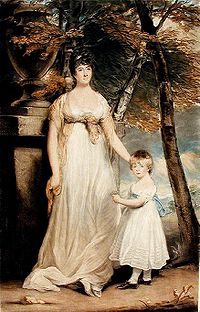Annotation:Lady Cholmondley's Waltz: Difference between revisions
No edit summary |
m (Text replacement - "garamond, serif" to "sans-serif") |
||
| Line 2: | Line 2: | ||
---- | ---- | ||
[[File:cholmondeley.jpg|300px|thumb|left|Lady Cholmondeley and her son Henry (1805), by Charles Turner]] | [[File:cholmondeley.jpg|300px|thumb|left|Lady Cholmondeley and her son Henry (1805), by Charles Turner]] | ||
<p><font face=" | <p><font face="sans-serif" size="4"> | ||
'''LADY CHOLMONDLEY'S WALTZ'''. English, Waltz. D Major. Standard tuning (fiddle). AABBCC. The Cholmondeley family have lived at Cholmondeley Castle since the 12th century, surrounded by a 7,500 acres estate near Malpas, Cheshire. From the dates of publications containing the melody, it may be surmised that Lady Cholmondley was perhaps Lady Georgiana Charlotte Bertie, the wife of George Cholmondeley (1749–1827), 1st Marquess of Cholmondeley, whom she married in 1791. Through this marriage the ancient hereditary office of Lord Great Chamberlain came into the Cholmondeley family. Her daughter was Lady Charlotte Georgiana Cholmondeley (1795–1828), who married Lieut.-Col. Hugh Henry Seymour in 1818. | '''LADY CHOLMONDLEY'S WALTZ'''. English, Waltz. D Major. Standard tuning (fiddle). AABBCC. The Cholmondeley family have lived at Cholmondeley Castle since the 12th century, surrounded by a 7,500 acres estate near Malpas, Cheshire. From the dates of publications containing the melody, it may be surmised that Lady Cholmondley was perhaps Lady Georgiana Charlotte Bertie, the wife of George Cholmondeley (1749–1827), 1st Marquess of Cholmondeley, whom she married in 1791. Through this marriage the ancient hereditary office of Lord Great Chamberlain came into the Cholmondeley family. Her daughter was Lady Charlotte Georgiana Cholmondeley (1795–1828), who married Lieut.-Col. Hugh Henry Seymour in 1818. | ||
<br> | <br> | ||
| Line 10: | Line 10: | ||
<br> | <br> | ||
</font></p> | </font></p> | ||
<p><font face=" | <p><font face="sans-serif" size="4"> | ||
''Source for notated version'': the 1823–26 music mss of papermaker and musician Joshua Gibbons (1778–1871, of Tealby, near Market Rasen, Lincolnshire Wolds) [Sumner]. | ''Source for notated version'': the 1823–26 music mss of papermaker and musician Joshua Gibbons (1778–1871, of Tealby, near Market Rasen, Lincolnshire Wolds) [Sumner]. | ||
<br> | <br> | ||
<br> | <br> | ||
</font></p> | </font></p> | ||
<p><font face=" | <p><font face="sans-serif" size="4"> | ||
''Printed sources'': Sumner ('''Lincolnshire Collections, vol. 1: The Joshua Gibbons Manuscript'''), 1997; p. 33 (set for three instruments). | ''Printed sources'': Sumner ('''Lincolnshire Collections, vol. 1: The Joshua Gibbons Manuscript'''), 1997; p. 33 (set for three instruments). | ||
<br> | <br> | ||
<br> | <br> | ||
</font></p> | </font></p> | ||
<p><font face=" | <p><font face="sans-serif" size="4"> | ||
''Recorded sources'': | ''Recorded sources'': | ||
<font color=teal> | <font color=teal> | ||
Revision as of 14:10, 6 May 2019
Back to Lady Cholmondley's Waltz

LADY CHOLMONDLEY'S WALTZ. English, Waltz. D Major. Standard tuning (fiddle). AABBCC. The Cholmondeley family have lived at Cholmondeley Castle since the 12th century, surrounded by a 7,500 acres estate near Malpas, Cheshire. From the dates of publications containing the melody, it may be surmised that Lady Cholmondley was perhaps Lady Georgiana Charlotte Bertie, the wife of George Cholmondeley (1749–1827), 1st Marquess of Cholmondeley, whom she married in 1791. Through this marriage the ancient hereditary office of Lord Great Chamberlain came into the Cholmondeley family. Her daughter was Lady Charlotte Georgiana Cholmondeley (1795–1828), who married Lieut.-Col. Hugh Henry Seymour in 1818.
Lincolnshire fiddler Joshua Gibbons set the tune in they key of 'G' major in his original early 18th century mss. In America, the melody appears in the music manuscript collections of New York keyboard player Ann Winnington (c. 1810). Published American versions include Robinson's Massachusetts Collection of Martial Musick (3rd ed., 1826), Paff's Gentleman's Amusement, No. 1 (New York, 1812), Ball's Gentleman's Amusement Book 3, (New York & London, c. 1830), Williams' New and Complete Preceptor for the Fife (Utica, N.Y., 1819), and Whiteley's Instrumental Preceptor (Utica, N.Y., c. 1816).
Source for notated version: the 1823–26 music mss of papermaker and musician Joshua Gibbons (1778–1871, of Tealby, near Market Rasen, Lincolnshire Wolds) [Sumner].
Printed sources: Sumner (Lincolnshire Collections, vol. 1: The Joshua Gibbons Manuscript), 1997; p. 33 (set for three instruments).
Recorded sources: North Star Records NS0038, "The Village Green: Dance Music of Old Sturbridge Village."
